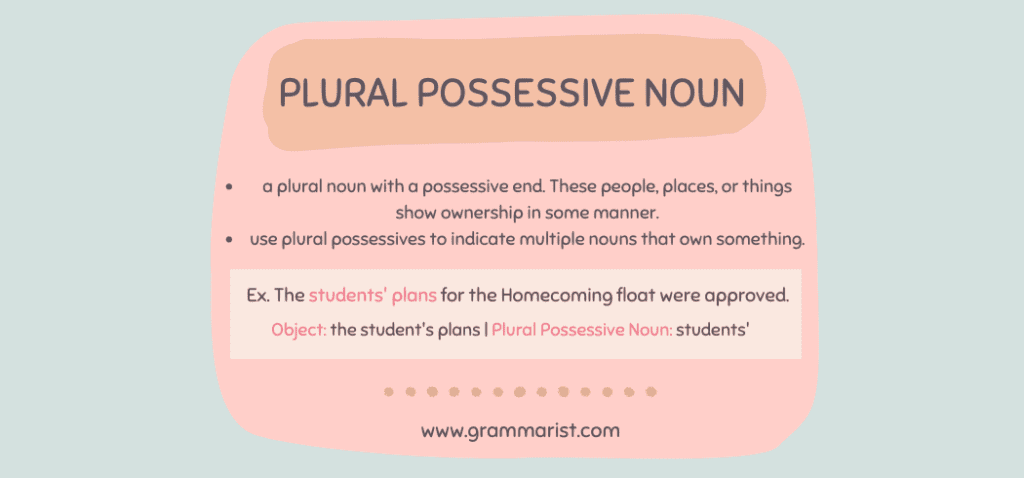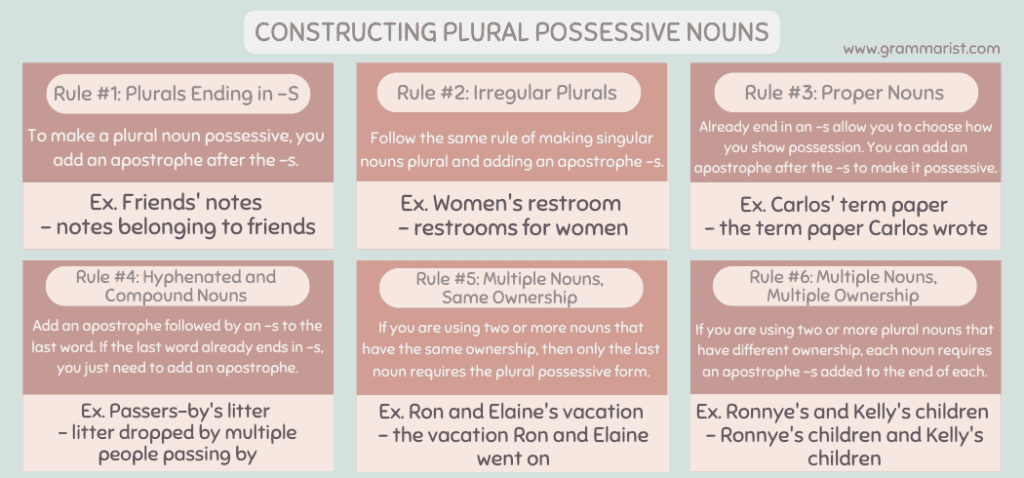The majority of English speakers struggle with apostrophe placement, especially when trying to show ownership. Does the apostrophe go before the -s or after?
If you struggle to find the answer, you aren’t alone. However, despite their nefarious-sounding name, plural possessive noun examples aren’t tricky to understand.
To prove this point to my students, I make sure we work together to redefine each part of the tongue-tying name. Reminding them that they know what plural, possessive, and noun means helps them realize they aren’t dealing with a trick question.
Knowing how to properly punctuate plural nouns to show ownership is important for grammatical clarity. It is a skill you need to master if you want to be understood. Let’s first look at possessive rules and plural nouns and then take the leap to better understand how you can combine them.
Reviewing Nouns
Nouns are simple. There aren’t multiple types of nouns to muddy the waters and make it difficult to apply grammar rules. Nouns are defined as a person, place, thing, or idea and serve as the subject and/or object of a sentence.
Nouns can be singular or plural, meaning there is only one or many.
Nouns can also be possessive, meaning they show ownership. A singular form of a noun is straightforward. To show possession with a singular noun usually only requires the addition of an apostrophe -s.
But, plural possessive nouns can be more complex, especially if they already have a -s located at the end of the word.
What is a Plural Possessive Noun?

Once my students remember what a noun is (it’s amazing how quickly the regular use of simple parts of speech makes you forget how they work), it isn’t hard for them to define a plural possessive noun.
A plural possessive noun is a plural noun with a possessive end. These people, places, or things show ownership in some manner.
For example:
- The students’ plans for the Homecoming float were approved.
This sentence shows that the object of the sentence, the students’ plans, belongs to more than one person. The plans belong to the students. There is more than one student, and there is more than one set of plans.
When to Use Plural Possessives
Use plural possessives to indicate multiple nouns that own something.
Constructing Plural Possessive Nouns

The basic rules for plural possessive construction are not difficult to apply. All plural possessive nouns end in -s, but the placement of the apostrophe changes depending upon starting noun form. Although consistent, it is important to note the rare exception to the rules relating to whether the apostrophe belongs before or after the -s.
Rule #1: Plurals Ending in -S
Almost all the plural words end in an -s. To make a plural noun possessive, you add an apostrophe after the -s.
For example:
- Friends’ notes – notes belonging to friends
- Teachers’ lesson plans – lesson plans written by teachers
- My sons’ weekend jobs – The weekend jobs my sons have
Rule #2: Irregular Plurals
Irregular plurals are those that don’t end in -s. To make these nouns possessive, you follow the same rule of making singular nouns plural and adding an apostrophe -s.
For example:
- Women’s restroom – restrooms for women
- Children’s school – school for children
- Cacti’s flowers – flowers on the cacti
Rule #3: Proper Nouns
Proper nouns that already end in an -s allow you to choose how you show possession. The majority of nouns do not end in an -s, but in the chance they do, you have more than one choice to make them possessive.
You can add an apostrophe after the -s to make it possessive.
For example:
- The Clements’ Family Reunion – A family reunion of the Clements
- Carlos’ term paper – the term paper Carlos wrote
- Nicholas’ camping trip – the camping trip Nicholas went on
You can also choose to show possession by following the noun with an apostrophe -s.
For example:
- The Clements’s Family Reunion
- Carlos’s term paper
- Nicholas’s camping trip
Rule #4: Hyphenated and Compound Nouns
Hyphenated and compound nouns require a few changes to both words to make it plural. To make it possessive, you need to add an apostrophe followed by an -s to the last word. If the last word already ends in -s, you just need to add an apostrophe.
For example:
- Passers-by’s litter – litter dropped by multiple people passing by
- Commanders-in-Chief’s laws – laws made by multiple chief commanders
Rule #5: Multiple Nouns, Same Ownership
If you are using two or more nouns that have the same ownership, then only the last noun requires the plural possessive form. You do this by adding an apostrophe -s.
For example:
- Ron and Elaine’s vacation – the vacation Ron and Elaine went on
- Emmett and Wyatt’s dogs – the dogs that belong to both Wyatt and Emmett
- Ginger and Gypsy’s new dog toys – the toys that belong to both Ginger and Gypsey
Rule #6: Multiple Nouns, Multiple Ownership
If you are using two or more plural nouns that have different ownership, each noun requires an apostrophe -s added to the end of each.
For example:
- Ronnye’s and Kelly’s children – Ronnye’s children and Kelly’s children
- Jonathon’s and Carlos’s SAT scores – The separate SAT scores of Jonathon and Carlos
- Sarah’s, Paris’s, and Lily’s new classes – the new classes Sarah, Paris, and Lily are enrolled in.
Plural Possessive Apostrophe Examples in Sentences
To help drive the proper grammar of plural possessives home, let’s look at more examples and then practice with our own.
- My home’s security system needed a new update.
- My classroom’s thermostat hasn’t been working correctly.
- The men’s hunting trip was rained out.
- The Davis’s always decorated their home for the Holidays.
- My sons-in-law’s vacation to Aruba was booked for next summer.
- Tim and Beth’s new home had a pool and three-car garage.
- Jill’s and Tom’s new horses came from the same ranch.
Let’s Review
Plural possessive nouns are used in a sentence to show ownership by more than one person, place, or thing.
The placement of the apostrophe that dictates plural possession is dependent on how the noun is presented to begin with. Plural nouns ending in -s simply need the addition of an apostrophe, while others need the apostrophe -s similar to a singular possessive noun. Proper nouns ending in -s may either be followed by an apostrophe or use the apostrophe -s.